8th Aero Squadron
8th Squadron
8th Attack Squadron
8th Bombardment Squadron (Light)
(1917-1941) |
Acknowledgment: Special thanks to Hans Petermann of San Diego, California for his assistance in providing research materials
and proofing the text. Special thanks to Ed Shook for his providing the invaluable materials on the early history of the 8th.
Also thanks to Dave Bradburn for his narratives. Thanks to the marvelous historical site of the 3rd Wing History Office of Elmendorf AFB, AK for its historical materials. We are deeply indebted to
the Joe Baugher website for its wealth of historical information on aircraft. Major source of
information: History, 8th Bombardment Squadron (L), 3d Bombardment Group (L) AAF, 31 May
1917 - 31 March 1944 (Compiled September 1945).
Squadron InsigniaThe Squadron insignia was adopted in February 1924. The official description
is as follows: "An American Eagle with outspread wings, clutching the top of
the Liberty Bell super-imposed upon a ring target." This insignia was chosen
because the 8th was the first American Air Service unit to use the deHavilland
DH-4 aircraft in combat, powered by the famous Liberty engine. The Liberty
Bell and the American Eagle have always symbolized America's stand for freedom.
The combination of Air Service, the Liberty Bell, the American Eagle and the
Liberty engine all contribute to make this an appropriate insignia to be
officially adopted by the 8th Squadron.
According to the Monthly Unit History, 8th Attack Squadron, May 1944, "The 8th Squadron insignia first appeared in World War I when the Squadron,
then known as the 8th Aero Squadron, began operations in France in 1918, as the
first United States air unit equipped with American built DH-4 attack and
reconnaissance planes. Captain S. H. Wheeler, the Squadron C.O., was
personally responsible for designing the insignia. The eagle carrying the
Liberty Bell represents the first American built airplane equipped with the
Liberty engine. The concentric rings of yellow and green are the Squadron
colors. This insignia was not, however, officially approved by the Adjutant
General until February 14, 1924. ..." (NOTE: Captain Sheldon H. Wheeler was
the first commander of the 8th Aero Squadron from 31 May 1917-1 May 1918. He
would later have Wheeler Field in Hawaii named after him.) 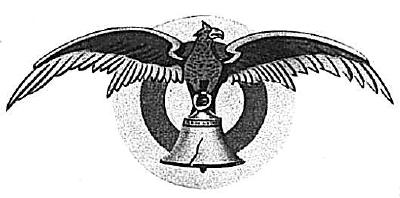 8th Aero Squadron insignia 8th Aero Squadron insignia
Approved February 14, 1924 (8401 A.C.)The quasi-official motto was "The Liberty Squadron" from the days of its
inception flying the deHavilland DH-4 "Liberty Plane." This motto was
resurrected in the Vietnam period with the 8th Special Operations Squadron
flying A-37Bs.
Unofficial Motto: "The Friendly Eighth." This motto was used throughout the
Korean Conflict. However, how it came about and exactly when it started being
used is unknown. David D. Bradburn, M/Gen, USAF, Ret wrote, "The 8th was called "The Friendly 8th" for no reason
that I know of, as early as fall of 1950 at Iwakuni, where there was a sign
with that inscription in the bar. So this moves it back a little, but doesn't
say, 'Why.'"
  8th Bomb Squadron Orderly Room with original insignia (Spring 1952) 8th Bomb Squadron Orderly Room with original insignia (Spring 1952)During the Korean War during 1952, the squadron started using a new version of
the Liberty Eagle and it started to appear on squadron signs in K-8 and on the
squadron hats. 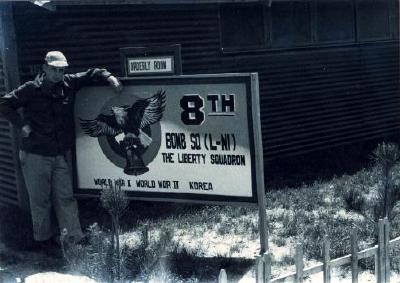 Jack Barclay with the new 8th Bomb Squadron Orderly Room sign (1953) Jack Barclay with the new 8th Bomb Squadron Orderly Room sign (1953)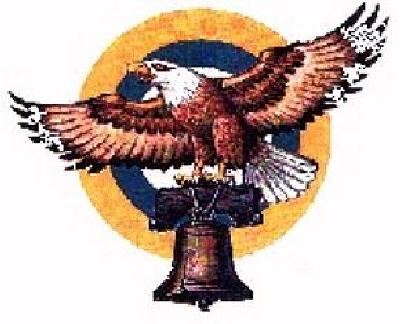 8th Bomb Squadron insignia 8th Bomb Squadron insignia
Approved June 21, 1954 (KE 8387)After the Korean War, the B-57 pilots wore the emblem on their flightsuits or
on the organizational caps. When the squadron was deployed to Vietnam, it
proudly took the Liberty Eagle with it.
When the unit transitioned to A-37Bs in Sep 1970, the emblem was still with the
unit. However, the squadron assumed the nickname of the 604th SOS, "RAPS" when
it took over its equipment and men at Bien Hoa, Vietnam. 
8th SOS Patch (1971)
(Richard Dutcher)In 1972, the 8th Special Operations Squadron became a "paper unit" without men
or equipment and in 1973, its designation became the 8th Fighter Squadron for
administrative purposes. Finally in 1974, it was redesignated as the 8th
Special Operations Squadron again. It moved without men or equipment to
Hurlbert Field at Eglin AFB, Florida in Mar 1974. 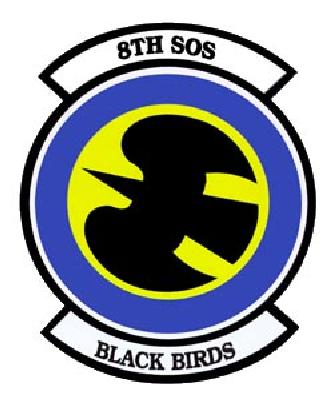 On a Yellow disc within a Blue band, On a Yellow disc within a Blue band,
edged with a narrow White border, a stylized climbing bird,
which is entirely Black.
MOTTO: BLACK BIRDS.
Approved on 19 Jul 1993The motto "Black Birds" came from the Vietnam War years when the MC-130E first
started operations. Painted black for its special operations roles, the
aircraft was viewed with awe and wonder.
History
World War IThe 8th Special Operations Squadron traces its roots to the 8th Aero Squadron of WWI flying deHavilland DH-4s. The 8th Aero Squadron was activated May 31,
1917 per Special Order #16, Hq., Southern Departments. The enlisted personnel
were drawn from 2nd Company, 1st Provisional Aviation Camp, Kelly Field, Texas.
Capt S.H. Wheeler was appointed as the first commander of the unit. Arthur
Young, First Sergeant. (NOTE: Captain Sheldon H. Wheeler was the first
commander of the 8th Aero Squadron from 31 May 1917-1 May 1918. He would
later have Wheeler Field in Wahiawa, Hawaii named after him.)

Major Sheldon H. Wheeler, Department of Military Aeronautics,
pictured at Carlstrom Aviation Field, Arcadia, Florida
on June 16, 1918.
The 8th Aero Squadron was organized on June 21, 1917 at Kelly Field, Texas for
hasty training. It was hurriedly sent by train to Selfridge Field, Mount
Clemens, Michigan in July 1917. Along with the 9th Aero Squadron, they
constructed the field. For three-and-a half months, they trained cadets,
aviation mechanics, fitters and riggers.
The squadron left Selfridge Field on October 17 for Garden City, New York
arriving on October 28. According to the Narrative History, 1917-1941, the time at Garden City was spent in "perfect discipline."
On November 22, the squadron boarded the Royal mail ship, Carpathia, and
arrived in Liverpool, England 16 days later. After a three-week rest stay, the
squadron was divided into four sections and sent to different Royal Aviation
Training Centers. On December 8, 1917 the unit arrived at Dartford, England
while Transportation went to Ruislip; one flight to Thetford, one flight to
Wyton and one flight to Joyce Green, Northolt, England.
On May 1, 1918, the squadron was reassembled at Thetford, England under the
command of 2Lt Jacob D. Halstead. The unit was sent to Southhampton on July 17
for transport to France. The unit crossed the channel and landed at LeHavre
and proceeded to the rest camp at St. Maixant. From here, the unit proceed in
box cars to Amanty (Wuese), Zone of Advance. Amanty, France was the
Observation Training Center of the First Corps. Lt Halstead was replaced by
1Lt George Englehart, the Supply Officer who was senior in rank. While here,
pilots and observers were assigned by the personnel bureau, Office Assistant
Chief of Air Services. On August 2, 1Lt John Gilbert Minant (later Governor of
New Hampshire and Ambassador to England) assumed command. (NOTE: AFHRA: 8th SOS states the unit whereabouts unknown, 21 Jun 1917–31 Aug 1918; IV Corps
Observation Group, 31 Aug 1918; VI Corps Observation Group, 23 Oct 1918–5 Feb
1919)
From there it moved to Ourches, France on August 1918; Toul, France Sept 1918;
Saizerais, France October 1918. It distinguished itself with WWI Campaigns in
the Toul Sector, Chateau Thierry, Lorraine, St. Mihiel and the Argonne-Meuse
first and second offensives. In these actions it flew combat missions as a
Corps observation unit with the IV and VI Army Corps from August 25 - November
11, 1918. 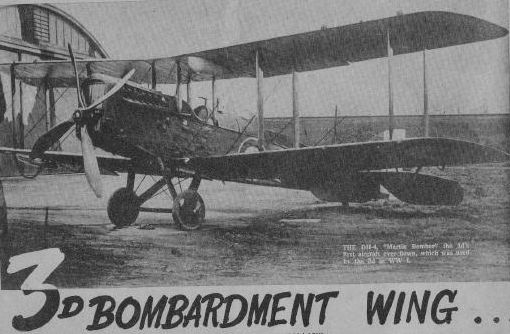
DeHavilland DH-4 ("Martin Bomber") that the 8th Aero Squadron flew in WWI
(1965 Yokota AB "Afterburner" Base Newspaper: Courtesy Norman Hartman) The Armistice was signed on November 11, 1918. In the post-War period, the
unit moved to Colombes-les-Belles, France in February 1919; and then on to
Fargues-St. Hilaire, France from February 22, 1919 - April 18, 1919.
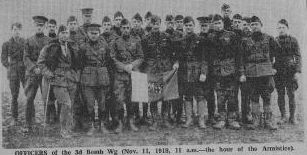
Officers of 8th Aero Squadron after Armistice (11 Nov 1918 at 11 am -- the hour of the Armistice.)
(1965 Yokota AB "Afterburner" Base Newspaper: Courtesy Norman Hartman) The following is from History, 8th Bombardment Squadron (L), 3d Bombardment Group (L) AAF, 31 May
1917 - 31 March 1944 (Compiled September 1945): Planes and all necessary materiel for active service were supplied by the Firat
Air Depot, Colombes Les Belles, and a small part of the transportation obtained
from Langres. The prescribed quota of transportation was never received by the
Squadron and more than once the efficiency of the Squadron was impaired by the
shortage. While at Amanty, advantage was taken of the short distance from the
lines, and a fortnight period of intensive training was engaged in, which
included flights into the enemy's territory.
On August 21, 1918, the Squadron moved by truck to Ourches, Meuse. On this day
as a result of a flat turn and a crash, 2nd Lt. Edwin R. Kingsland was killed
and Cpl. Hand, who was riding with him, seriously injured. The 8th was the
second Liberty Squadron to reach the front. The Squadron engaged at once in
active service, and on September 12 and 13 took part in the 'operations against
St. Mihiel Salient. (3). Lieutenants H.B. Rex and W.F. Gallagher were killed
during this engagement, and Lieutenants H.W. Mitchell and J.W. Artz reported
among the missing. Later, it was found that Lt. Mitchell was shot down over the
lines in a fight with a Hun. He was unhurt; Lt. Artz was slightly wounded.
Because of the shortage of observers at this critical time, the Squadron
Commander, taking advantage of paragraph l342.5, Army Regulations, placed
Sergeant First Class Phillip G. Smith, sergeant E. O. Cook, and Sergeant Frank
W. Noal on flying status, and used them as aerial observers. On his fourth flight, Sergeant Noal was killed with Lt. Frank B.
Hollingsworth, shortly after the St. Mihiel attack. This accident happened as
they were leaving the field on a reconnaissance mission. The pilot made a flat
turn, spun to the ground and
crashed. Both pilot and observer were instantly killed. 'Ihe other two
non-commissioned officers performed excellent service over the lines. Each of
them is officially credited with the destruction of an enemy airplane. While at
Ourches, 2nd Lt. Paul W. Chase and 2nd Lt. Ray Smith were given official credit
for the destruction of a Boche plane.
On September 29, 1918, the entire Fourth Corps Group moved up to Toul
Aerodrome, which is situated about two kilometers northeast of Toul, Mourth, Et
Moselle, France. The Squadron remained here little less than a month. During
this time considerable work was accomplished. At the suggestion of Col. Kahn, two photographic planes were sent out on single
missions with protection, instead of one machine. On such a trip made September
25, a string of pictures covering some forty kilometers were taken. This was
one of the longest, if not the longest strip photographed by an American
Observation squadron on a single mission. One of the duties assigned the Squadron at this time was to photograph the
entire Corps front to a. depth of ten kilometers, an area of six hundred square
kilometers. A large part of these pictures had been taken before the Squadron
was transferred to the Sixth Corp. On October 9, 1st Lt. Edward R., Moore and 1st Lt. Gardner P. Allen while on a
photographic mission displayed extraordinary heroism for which they were later
awarded the Distinguished Service Cross. The next day, one of the best teams in
the Squadron, 1st Lt. Robert J. Cochran and 1st Lt. Claude S. Garrett, Flight
commander of Flight "C" were brought down in flames while taking pictures.
They, with three other planes, were attacked by twenty-six Boche. Three of
these Boche were brought down, two by Sgt. F.G. Smith and one by Lt. S.
Chambers. These two officers had won the respect and admiration of both officers and
enlisted men of the Squadron. Their death was a real loss to all. Before
leaving Toul, 2nd Lt. Jacob D. Halstead was transferred to the Group as Post
Adjutant, 2nd Lt. Charles W. Richard was made Group Radio Officer. Both
officers had been active helpers in making this an efficient organization. Lt.
Walter Bender was relieved as Squadron Operations Officer and made Squadron
Adjutant. Lt. M. G. Riley was appointed
Squadron operations Officer.
On October 23, the squadron was moved to Saizerais and attached to the Sixth
Army Corps, where shortly after arrival it was joined by the 354th Aero
squadron. This squadron had just arrived on the front and in order to place
experienced flyers in the Squadron, Major McNarney ordered seven pilots and
seven observers transferred to the 354th Squadron. Lt. H.P.. Young was
appointed Operations Officer and Lts. A. C.Rothwell, T.H. Menke and I.D. stone
were made Flight Commanders. While
at Saizerais and before the Armistice was signed, five officers were lost. Lts.
Walker Royce and J.J. McVaine, and Lts. Clark Robinson and R.O. Watson were
missing over the lines. All four, it was later learned; were taken prisoners;
1st Lt. Alex R. Dean was killed in an airplane accident, while attempting to
accomplish an Infantry Liaison exercise with Corps Troops.
Both at Toul and Saizeraia a number of voluntary bombing missions were carried
out. These met with success. While at Saizerais, one Hun machine was destroyed
and officially credited to Lt. F. B. Fort and Sergeant B.B. Cook. The Squadron
was actively engaged on the front for two and one half months and during nine
hundred hours of flying had only one forced landing. Not a single case arose that required a court-martial. The enlisted personnel
did cheerfully and well every task assigned to them. The total losses were
eight killed, three injured, and six missing. All that was given to the
Squadron, was done, and done to the limit of its ability.
On February 5, 1919, G-3 order.s NJ. 129, Headquarters, 2nd Army, were received
relieving the Squadron from the. 2nd and 6th Army Corps and assigning it to the
advance section, S.O.S., with instructions to proceed by truck train to
Colombes les Belles, France, for preparation to return to the United states.
This was hailed with joy by every member of the organization as it was realized
that they were not doing any good where they were since the Armistice. However,
a great deal ~of regret was felt, as the organization was such a splendid one.
To think of its dissolution as a unit was sorrowful, but "c'est La Guerre".
When this order was received the organization had nineteen pilots and
twenty-four observers on its rolls and fourteen planes in addition to the usual
ground officer personnel. Under G.H.Q. orders, only ten officers were allowed
to be taken with the Squadron so it became necessary to detach the surplus
officers. The planes were to be delivered to N.S. Production Center at Romarantin,
France, a distance of about four hundred miles from the airdrome. One plane,
however, was transferred to the 354th Squadron, leaving only thirteen planes to
be disposed of. On February 8, 1919, the start was made in two formations of
six and seven, taking off in six inches of snow at about 9:00 A.M. in almost
zero weather.
The Flight Leaders were given orders to land at Orley near Paris for gas and
oil and then proceed to their destination. One plane was forced to land because
of losing the drain plug from its water pump
while in the air. A safe landing was made, however, and the plane was later
flown to destination. By 9:00 P.M. February 8, 1919,. all planes had been heard
from and were safe. The 8th Aero Squadron was a ground unit.
During most of March and during the time Captain John G. Winant had been in the
hospital and absent on leave, 1st Lt. Walter Bender was in command. Another
problem which presented itself was the disposition of the Squadron property.
With the assignment of 2nd Lt. Rayburn S. Webb as Supply Officer, this was soon
accomplished.
On February 10, all the pilots who had flown planes to Romarantin had returned,
and orders were issued sending them to the 1st Air Depot for duty and return to
the united states.
On February 11, everything was in readiness and the move to Colombes les Belles
was made by truck. Here the squadron was quartered in Adrian Barracks and
immediately put on fatigue with other squadrons preparing the depot for
inspection by General. Pershing.
On February 16, Captain Winant was relieved of command and. Lt. Bender assumed
command. 'Ihe same date Lt. Raymond Sanderhoff was sent as advance party to
Bordeaux to prepare for the Squadron's arrival.
On February 19, the Squadron entrained at Barisey-la-Cote, for St.
Andre-de-Culizac. Seven box cars were assigned the Squadron for officers and
men. Five days were consumed on the move to Bordeaux where, upon arrival,
billets were assigned to officers and men in the small village of Forgues-st.
Hilaire. The billets were the usual French rooms but the men were very
comfortable. The Squadron Commander and his Adjutant were, assigned one of the
largest chateaux in the village,
splendidly furnished and equipped with billiard tables and a huge library .
The squadron remained here until April 19, 1919 spending the time in preparing
for embarkation. The records of the squadron were brought up to date. From six
to eight hours daily were spent at drills
and tactical marches. A baseball team was organized and some good games played
and won. Everything possible was done by the townspeople to make our stay
pleasant and we left this village with regret.
The Squadron remained here until April 19 and then moved by marching to Camp
Genicort, a distance of about ten kilometers, and went through the delousing
mill the same day. The next few days were days of work and sleep for officers
and the office force as the volume of typewriter work was mountainous. Here
seven officers were relieved from duty with the Squadron, leaving only three
officers to return to the United states with the organization.
On April 20, 1919, the reign of terror of final preparation for return was
completed and found the squadron on board - the U.S.S. "Pastores" with the
shores of La Belle, France, receding in the distance.
The crossing was made with fine weather and on the evening of May 1, the Lady
of Liberty was sighted, thrusting her candle above the horizon. The Squadron
was once more in the land of its birth.
On May 2, 1919, the Squadron debarked and moved by ferry and train to Camp
Mills, Garden City, and was once again deloused. On May 3, the organization
moved to Mitchell Field, Long Island,
and the work of transferring the enlisted men to different cantonments for
discharge commenced. This was completed by May 20, and the Squadron then consisted of one officer,
1st Lt. Walter Bender, and eight men, all of whom were on furlough.
On May 20, orders were issued sending the squadron to Kelly Field, Texas, for
station and duty, at which place it arrived on May 25, consisting of one
officer and records.
On May 31, 2nd Lt. F. Taylor was attached to the Squadron, assuming command,
and Lt. Bender left for Los Angeles on a thirty-day leave.
During June 1919, the eight men who had been on furlough reported back to the
Squadron and were immediately transferred, leaving the Squadron with one
officer on leave and one officer attached for the personnel. During WWI, the 8th Aero Squadron was engaged in active combat through out
France for over two and a half years. They logged over 900 combat hours on
photographic/bombing missions in the DeHavilland DH-4, "Liberty Plane", with
only one forced landing and four enemy aircraft kills credited.
de Havilland DH-4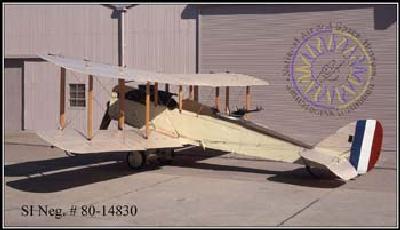 deHavilland DH-4 deHavilland DH-4
(National Aeronautical & Space Museum)According to the Smithsonian Institute:
"The versatile de Havilland DH-4 played many roles in both military and
civilian capacities. In addition to its bombing activities in World War I, the
DH-4 was an observation and photoreconnaissance aircraft. Between the Wars, one
of its most important tasks was aerial mapping for the Army Air Service."
The DH-4 was introduced in England in 1917. Because of the War, time for new
aircraft development was limited, so an American version of the already
existing aircraft was produced in this country. More than 4000 DH-4s equipped
with the American Liberty Engine were manufactured in the U.S. by 1919. The Air
and Space Museum's aircraft is the first of these to be built.
After the War, modifications were made to correct design and safety flaws and
the "Liberty Planes", as the DH-4s were called, were used in many fields,
including forest patrols, geologic reconnaissance, and aerial photography. The
Army Air Service was called upon to supply the Army Corps of Engineers and the
Geological Survey with aerial photos for mapping and stereo viewing. The DH-4
was the most suitable and, because of its great numbers, the most available
plane for the job. It was used as the standard airplane for the purpose for 10
years.
Aerial cameras in the DH-4 could be hand-held or mounted either inside or
outside the rear cockpit. The aircraft on display contains a Kodak L-4 camera
positioned within the cockpit to take photographs through a small window in the
floor.  deHavilland DH-4 deHavilland DH-4
(National Aeronautical & Space Museum)The following is an excerpt from an article by John Lienhard of the University of Houston: "Why," wondered National Air and Space Museum Director Walter Boyne, was "the
United States, which had given birth to the airplane ... so absolutely
indifferent to its development [before WW-I]?" Then he goes on to tell us about
the deHavilland DH-4.
By the time war began in 1914, Germany had spent 45 million dollars on military
aviation, Russia 23 million, and France 13. America had spent hardly 400
thousand dollars on military aircraft. Boyne answers his own question. There
was no apparent money in aviation. We'd invested everything in railways and
highways.
All we had was the Curtis Jenny. In 1915 it went to war, not against Germany,
but against Pancho Villa in Mexico. Eight Jennies and ten pilots were no match
for the harsh Southwest. Jennies weren't meant to go more than about fifty
miles from their base. They crashed and got lost. Pershing never did catch
Pancho Villa.
When we finally entered the War, we appropriated 13 million dollars for
airplanes and went to the European airplane builders for designs. The British
deHavilland Company had built a series of airplanes, the best of which was the
Rolls-Royce-powered DH-4. The British finally sent us one to use as a template.
So we set out to build DH-4s. In the end, we spent 640 million dollars on them.
We switched from the British system of hand-crafting airplanes to our
automobile production methods. We developed our own so-called Liberty Engine --
a large 400 HP water-cooled V-12 machine. The American-built DH-4 was renamed
the Liberty Plane. At first it had so many design bugs people called it The
Flaming Coffin. When my father joined the Air Service, late in the war, he
trained in Jennies. The Liberty Plane never did reach him.
But it did reach France in May, 1918. The DH-4's combat service was not
distinguished. It was far too ponderous to dogfight the German Fokker triplanes
and biplanes. It didn't carry enough load to be a useful bomber.
It was a clear matter of too little and too late, but there's more to the
story. Thousands of DH-4's were left in America on Armistice day, and even more
Liberty Engines. The DH-4 hadn't been worth much in combat, but it was a big
solid stable biplane with a tubular steel frame and what turned out to be a
fine engine. When you crash-landed a DH-4, you walked away alive.
Right after the war, the Army began airmail service with DH-4s. DH-4s with skis
served in the Arctic. Engineers modified them every way imaginable. The Liberty
Engine was so good we relied on it instead of moving ahead. It probably slowed
American aircraft engine development. And so the DH-4 takes a strange place in
aviation history. It couldn't stand up to the famous WW-I airplanes. Yet the
forgotten DH-4 was still in service when all that remained of Fokkers and Spads
were the legends that lingered after them.
Between the WarsReturning from WWI, the squadron was demobilized on 5 May 1919 at Mitchell
Field, Long Island, New York. The squadron was then sent to Kelly Field, Texas
on May 25, 1919. One officer and the Squadron records were transferred to
Kelly Field, Texas. After reorganization at Kelly Field, Texas on July 5, 1919
in which one officer and 150 men were assigned from Rockwell Field, California.
The Squadron was reorganized on a peacetime strength manning of two flights
and on July 16, 1919, Flight "A" left relocated to McAllen, Texas, where they
flew Mexican border patrol missions until June 1921. (SITE NOTE: On June 1919
Captain George Kenney returned to the U.S. after commanding the 91st Aero Sqdn
in WWI and was reassigned to the 8th Aero Squadron at McAllen, Texas. As a
three-star he would direct the South Pacific air war. He would rise to 4-star
rank in 1945 and head the Strategic Air Command in 1946.)
According to an Invader news article, "New personnel were drawn from Rockwell
Field, California, equipped with DH-4 aircraft and then divided into two
flights: one at Laredo Texas and the other at McAllen, Texas. These flights
were engaged in Border Patrol duty until they were re-assembled at Kelly Field
on June 30, 1921." (Source: Invader, news article, date unknown, Jack Lewis.)
Border Patrol Duty The 8th Squadron remained in Texas from June 1921 until March 1, 1935. The
8th conducted air operations patrolling of the Mexican border from August 1918
- June 1921. According to the 3rd Wing History, "Revolution and disorder had broken out in Mexico, resulting in border
violations and the killing of American citizens. The unrest prompted the
stationing of forces in southern Texas, including an aerial surveillance group.
Four units with World War I experience, the 8th, 12th, 13th (formerly the
104th), and 90th Aero Observation Squadrons, were grouped to form the Army
Surveillance Group. On 15 August 1919, the Army redesignated the group as the
1st Surveillance Group."
The following is from History, 8th Bombardment Squadron (L), 3d Bombardment Group (L) AAF, 31 May
1917 - 31 March 1944 (Compiled September 1945):
The personnel consisted of nine officers and 46 enlisted men. The airfield had
to be cleared by a construction squadron and by Aug 18, had succeeded in
clearing off enough cactus and mesquite for a safe landing with a JND4 and in
erecting seven tent hangars and several framed tent structures. The first
flight was made by this part of the Squadron on July 29, and as fast as planes
could be assembled, border patrol work started.
Squadron Headquarters end Flight "B" remained at Kelly Field until August 13,
1919, when Flight "B" left for Laredo, Texas, and Headquarters, consisting of
two officers and 17 men, joined the flight at McAllen.
'
Flight "B" was equipped with six DH4's which had been assembled at Kelly Field
and were flown down to Laredo and the Flight was ready to operate. Captain D.W.
McNabb was Flight Commander. Captain J. W. Ramsey had succeeded 1st Lt. Vincent
J. Meloy in command of Flight "A" at McAllen, Texas.
Work of building a permanent camp at both flight stations was started at once,
after their arrival at their respective stations. There was no money to buy lumber or other building material. However, seven
buildings were erected at McAllen by playing the old army game with the
Construction Quartermaster, and about the same number was erected at Laredo.
In August, 1919, the Squadron had the first casualty since the return from
overseas, Lt. F. Robinson being killed, and his observer, 2nd Lt. U. L. Reddy,
seriously injured in an airplane crash near Laredo.
During the same month, while flying patrol along the river from Laredo to
Zapata, 2nd Lt. Fonda B. Johnson and his observer, Captain McNabb, were fired
upon by Mexican troops and forced to land after bullets had pierced the
radiator of the plane. Captain McNabb sustained a. slight bullet wound in the
head from the Mexican fire and was evacuated to the hospital. Operations Split between McAllen and Laredo Flight "A" continued operations at McAllen Airfield and Flight "B" operated
from Laredo Airfield. During March 1920, the new DH4B's, ferried down to
McAllen and Laredo by Kelly Field pilots, "were put through the mill and it
wasn't long before all pilots began to sing their praises. They were specially
good for observation and liaison purposes since the new arrangements of
cockpits put the pilot and observer close together."
In May 1920, Lt. Mile McCune made the first pararoute jump of any station on
the border and without any previous experience or training along this line. Lt.
Fonda B. Johnson made a record jump at the Laredo Airdrome. No jumps were made
at McAllen as the parachutes had been sent to San Antonio for changes in
construction.
On August 3, 1920, orders were received to send Lts. Stoner, Crocker, Hartman
and Walthal with enlisted men, via airplane,and Lt. Virgin and thirty-five
enlisted men by train, to Pope Field, Fayetteville, North Carolina, to operate
in connection with the Artillery Shoots being carried on at Camp Bragg. The
group designated was Flight "B" from Laredo. With so many officers at Camp
Bragg, it left only Lts. McCune,
Glascock and McKiernan, with Captain Kice, surgeon, to carryon the necessary
duties at the Laredo Airdrome.
On May 15, 1921, Lt. Crocker from Laredo and Lts. Reynolds and Skanse from
McAllen, were ordered to join other officers proceeding to Langley Field via
train, to assist in the carrying out of project "B". Project "B" was the
official designation of the bombing test conducted off the Virginia coast, in
which obsolete battleships and captured German battleships were bombed and
sunk. A great amount of experience and training was obtained from this
expedition. Large planes were flown; latest bomb dropping devices were used;
bombs
weighing from twenty-five to 2,000 pounds were dropped; gas, smoke, phosphorus
and armor piercing bombs used; wireless telephone controls employed; flights
one hundred miles to sea were made. Sinking different type battleships, night
flying and bombing, and using parachute flares seventy-five miles out at sea
were all in the program of project "B".
Still flying the deHavilland DH-4, it was redesignated at the 8th Squadron (Surveillance) in June 1921. The group initially flew daily border patrols between
Brownsville, Texas and Nogales, Arizona. They turned into weekly patrols as
unrest along the border subsided. Brigadier General Billy Mitchell, a senior
staff officer in the Army Air Service, felt that border patrols had been a
waste of time. He foresaw a better use for the 1st Surveillance Group as an
attack unit. Since the group had been flying low-level observation missions and
many of its pilots experienced combat during World War I, General Mitchell
believed it ideal for the new mission. The Army redesignated it as the 3rd
Attack Group on 2 July 1921.
Squadron Returns to Kelly Field On June 20, 1921, all personnel and material was ordered from Laredo and
McAllen to Kelly Field, Texas, with the exception of three caretakers at each
station. On arrival at Kelly Field both flights were consolidated with Lt.
Heloy commanding and Lt. Glascock as Adjutant and Supply officer. Flight "B"
elements which had been deployed to Camp Bragg on September 26, 1921, were
transferred in name only from Camp Bragg to Kelly Field and the personnel consisting of 2 officers and
thirty enlisted men, were absorbed by the 22nd Squadron (observation).
During the month of July 1921 "many changes occurred due to the reduction and
reorganization of the Army. Fifty-five enlisted men were discharged and
seventy-five Air service men, part of a detachment of 200 men from March Field,
California, and twenty-two Signal Corps men, were attached to the Squadron."
The Squadron was seriously handicapped due to shortage of personnel. By 1922,
the total. strength of "fifty-two enlisted men; of which ten were absent on
various duties, twenty-two on extra and special duty, with only twenty men for
duty." Recruiting was slow, and only increased to near authorized strength on
December 31, 1922 with 119 men.
On September 15, 1921, the designation of the Group was changed from 1st
Surveillance Group to 3rd Group (Attack). The 3rd Attack Group returned to
Kelly Field in 1921 where it underwent an extended period of training.
The Squadron received on January 20, 1921, one of several armoured bi-motored
triplanes assigned to the Group. These planes were designed especially for
attack work and officially designated as GAX (Ground Attack, Experimental).
The outstanding features of these planes were the armoured protection for motor
and personnel, and mounting for a small rapid fire cannon: Experiments proved
this type , plane unsuitable for attack work and later they were discarded.
On May 26, 1922, a long-distance one-man non-stop record was set when Lt.
Crocker when he made a non-stop flight from the Mexican Gulf to the Canadian
Border, an approximate distance of 1200 miles, to demonstrate the mobility of
the Air Service. The course was from Ellington Field, Texas to the waters of
the Gulf thence to the Canadian border just below Detroit, Michigan, landing at
Selfridge Field. This distance was greater than from some other cities along
the Gulf, but since a large field was necessary for the heavily-laden plane to
take off, Ellington Field was selected as the starting point. The plane used
was a special built De Havilland and designated as DH4B1S. The main tank had a
gas capacity of 240 gallons and the reserve 28
) gallons, with a 24 gallon tank for oil. Taking off on May 26, he landed at
Selfridge after 11 hours and 55 minutes in the air.
In June 1922, the squadron provided flood-relief in the lower Rio Grande
Valley. A commendable piece of work was done by Lt. Selzer in July, 1922, in
connection with the Rio Grande flood at McAllen, Texas, in carrying mail to
towns without the, usual rail connections, assisting in locating marooned
parties caught by the rapid rising waters of the Rio Grande River, and in
cooperating with the other military authorities of that.
station during the critical time.
According to the 3rd Wing History, "Despite its successes, the 3rd Attack Group suffered from limited budgets at
the time. When Major Lewis Brereton, who would later command the Far East Air
Force during the early days of World War II, assumed command in February 1923,
he had to contend with the inactivation of two squadrons and the limitation of
flying hours. However, the Army began to expand in 1926, resulting in the
reactivation of a squadron. The group now consisted of the 8th, 13th and 90th
Attack Squadrons, an association that would last until 1964."
On January 25, 1923, the unit was redesignated as the 8th Attack Squadron.
In February 1924 the squadron's official insignia was adopted. The official
description is: "An American eagle with outspread wings, clutching the top of
the Liberty Bell superimposed upon a ring target." The insignia was chosen
because the 8th was the first American air service unit to use the DeHavilland
DH-4, "Liberty Plane", in combat. The combination of air service, the American
Eagle, the Liberty bell, and the "Liberty Plane" all contributed to make this
an appropriate insignia for the 8th.
On June 27, 1924, the Squadron was reorganized and placed on a reduced strength
status of sixteen officers and ninety enlisted men from the former strength of
twelve officers and 132 enlisted men.
Experiments proved the wing guns as practical and all planes of the
organization, excepting special cross country planes, were equipped with wing
guns during February 1925.
Move to Fort Crockett, Texas On June 28, 1926 the squadron moved from Kelly Field to Fort Crockett in
Galveston, Texas. The organization's planes with necessary personnel were
flown, in advance. The remaining troops were convoyed by truck. During it stay
at Fort Crockett, the group was called on often during its nine-year state at
Fort Crocket to participate in air maneuvers, demonstrations and air races.
During this time the squadron also flew many other types of aircraft. These
aircraft included the GAX (GA-1) in 1923; O-2 1926-1928; A-3 1928-1934; Curtis
A-12 Shrike 1934-1936 (including Curtis A-8s & O-19s during 1932-1936); and
Northrop A-17 1936-1940.
During this period, it participated in a great amount of work in connection
with "experiment, practice and development of aviation in in general and attack
aviation in particular. It progressed from the DH-4B type aircraft to the
A-12, which was the immediate forerunner of our A-17 and A-17A." (Source: Invader, news article, date unknown, Jack Lewis.) The Squadron was involved in the
development of light bomber tactics specifically. The 3rd Attack Group
pioneered low-level attack and close air support procedures.
It continued flying the deHavilland DH-4 until 1926. At Fort Crockett the
squadron began flying the Curtis A-3 Falcon in 1926. It boasted four forward
firing .30-caliber machine guns and another two on a flexible mount in the rear
cockpit. Powered by a 430-horsepower engine, the Falcon could carry 200 pounds
of bombs attached to wing racks. Although carrying a lighter bomb load, the A-3
proved better in the attack role than the DH-4. The A-3B replaced the A-3.
In 1934 the aircraft would be used to carry mail.
 A3B Falcon 3rd Attack Group (1930) A3B Falcon 3rd Attack Group (1930)
AAC maneuvers (Courtesy Tom Hegre)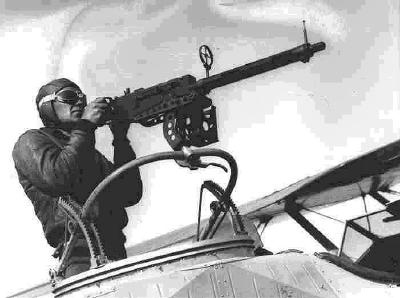 A3B Falcon 3rd Attack Group (1930) A3B Falcon 3rd Attack Group (1930)
AAC maneuvers (Courtesy Tom Hegre)The photos above were taken on maneuvers to Mather Field, California. On March
27,1930, a flight of nine planes left to participate in maneuvers.
The 3rd Attack Group resumed border patrols briefly again in 1929, after unrest
erupted in Mexico. It deployed 18 of its aircraft on patrol along the Mexican
border with Arizona in early April. The patrols lasted until early May when the
situation in Mexico stabilized. After the border patrols ended, the squadron
resumed its training activities at Fort Crockett.
It also flew the YA-8. On November l, 1932, Captain Lotha A. Smith departed
for Rockwell Field, California for the purpose of participating in service test
flight of the YA-8 airplanes, returning to Fort Crockett on November 7, 1932.
The YA-8, then an experimental plane, was considered the deadliest weapon of
the air corps for use against ground troops. It had a speed of about 200 miles
per hour. In addition to six machine guns it carried a demolition bomb between
the landing wheels. A squadron of these planes was said to equal the artillery
and machine gun fire of a full infantry division. The A-8 was the first three
propellor plane used by the group and was the type that Lt. Col Horace M.
Hickam, commander of the 3rd Attack Group, was flying when he crashed while
landing at the Fort.
On January 5, 1932 the organization received its first A-12 attack airplane
from the Curtis factory, Buffalo, N.Y., piloted by Captain A.H. Foster. By the
last of January the Squadron had ten A-12s and four A-3Bs assigned. By late
1932, the 3rd Attack Group had upgraded to the Curtis A-8 Shrike. The low-wing
monoplane represented the rapid advance in aircraft technology being achieved
despite the economic difficulties of the Great Depression. It carried 400
pounds of bombs and was armed with five .30-caliber machine guns. The group
received the A-12 Shrike, an improved version of the A-8, the next year.
 Curtis A12 Shrike 3rd Bomb Group (Light) Curtis A12 Shrike 3rd Bomb Group (Light)
Mail Service On February 12, 1934, in compliance with Executive Order 6591, dated February
9, 1934, the organization began preparation for duty in connection with
carrying the Air Mail. The Army Air Corps agreed to carry the US mail following
a government dispute with the commercial carriers. When the Air Corps started
to carry the mail in 1934 the 8th BS was one of the first Squadrons selected to
be used in this capacity. However, the 3rd Attack Group commander, Lt. Colonel
Horace Hickam, complained that his pilots were not trained and equipped for the
job, a concern shared throughout the small Air Corps at the time.
On February 13, 1934 three A-12 airplanes departed for Oakland, California. On
February 14, a flight of nine A-l2s 1eft for Omaha, Nebraska. All pilots and
airplanes were given practice runs before actually carrying the mail.
On.February l6, 2nd Lt. Jean D. Grenier, while making a practice flight over
the Salt Lake City -- Cheyenne air mail route, crashed on the western slope of
the Rocky Mountains, 35 miles east of Salt Lake City. Lt. Grenier and passenger
were killed and the airplane was demolished. The 3rd Attack Group lost two of
its pilots on the air mail route between Salt Lake City and Cheyenne during the
winter of 1934. On May l5, the Army terminated its connection with the
carrying of the mail and personnel and planes began returning to station. . The
Squadron returned to its routine duties.
Move to Barksdale Field, Louisiana On March 1, 1935., the Squadron moved by train with the Group to Barksdale
Field, Shreveport, Louisiana at which time it became a part of the General
Headquarters Air Force and became a Service Test Organization. "The Squadron
went immediately into a strenuous and successful training period which included
formation flying, attack and aerial gunnery, bombing night flying and many
navigation missions. The Eighth continued in this capacity until October 1940
and during this period participated in all the major field exercises and
tactical maneuvers through out the country." (Source: Invader, news article, date unknown, Jack Lewis.)
The Squadron was re-organized on March 13, 1935 and made into a Service Test
Organization with an authorized strength of 65 enlisted men. The newly
reorganized 8th Service Test Squadron with its eleven officers and three Flying Cadets immediately went into a
strenuous and successful training period which included formation flying,
attack and aerial gunnery, much bombing, night flying and many Navigation
Missions. The squadron ended 1936 with much better equipment, with extensive
training and with many new tactics developed in the art of Attack Bombing.
(NOTE: The 8th Service Test Squadron is NOT listed in the 8th lineage in AFHRA: 8th SOS. Source for "8th Service Test Squadron" is History, 8th Bombardment Squadron (L), 3d Bombardment Group (L) AAF, 31 May
1917 - 31 March 1944 (Compiled September 1945).)
On October 31, 1939, the 8th Attack Squadron was awarded the Harmon Efficiency
Trophy for being the most efficient organization in the 3rd Wing, General
Headquarters Air Force, during the Fiscal Year ending June 30, 1939.
According to the 3rd Wing History,
The 3rd Attack Group became a mobile strike force that worked directly with
ground forces. At the same time, it received the Northrop A-17 Nomad. Two years
later, the group upgraded to the A-17A, which featured retractable landing
gear. The all-metal attack plane, powered by an 825-horsepower engine, could
carry a 900-pound bomb load. It was armed with five .30-caliber machine guns.
(SITE NOTE: The A-17 was in service from 1937-1939 with the Squadron from
1937-1939.)
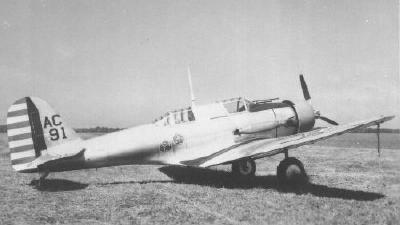 Northrup A17 3rd Bomb Group (1939) Northrup A17 3rd Bomb Group (1939)The 8th Attack Squadron also received 13 Curtis A-18 Shrike II's. This two-engine attack plane represented a technological advance. It carried
20 fragmentation bombs in the fuselage and up to four 100-pound bombs under its
wings. Four .30-caliber machine guns mounted in the nose provided concentrated
fire for strafing ground targets. It performed well, wining the Harmon Trophy
for gunnery and bombing accuracy during its first year of operations. In
September1939, the Squadron was assigned the B-18A aircraft. It was a Douglas
light Bomber powered by twin-engined Wright Cyclones.
 B-18 Bolo Bomber B-18 Bolo Bomber
This aircraft never saw action in World War IIThe Army redesignated the 3rd Attack Group as the 3rd Bombardment Group (Light)
on 15 September 1939. On September 15, 1939 the Squadron was redesignated as
the 8th Bombardment Squadron (Light).
On January 31, 1940, the squadron was split in half, both officers and enlisted
men leaving to form the 15th Bomb Squadron of the 27th Bomb Group at Barksdele
Field, Louisiana.
 A-20 Havoc A-20 Havoc
Move to Hunter Field, Georgia On October 6, 1940, the Squadron received orders to pack supplies and
equipment for a change of station to Savannah, Georgia. , One officer and 100
enlisted men departed from Barksdale Field on troop train, while11 officers and
54 enlisted men departed by privately owned vehicles. The men by troop train
arrived at Savannah, Georgia on October 8 and set up at the Municipal Airport.
The remainder of the personnel arrived on October 10, 1940 and the Squadron
began ferrying aircraft to the National Guard Armory. By October 20, equipment
was set up and operations begun. The airfield was officially named Savannah Air
Base.
It moved to Hunter Field, Georgia in October 1940. The Eighth continued in
this training capacity until October 1940 and during this period participated
in all major field exercises and tactical maneuvers though out the country.
The 3rd Bombardment Group spent its time at Hunter Field flying anti-submarine
patrols and practicing low-level attacks against shipping off the Atlantic
Coast.
 8th Squadron (1940) (Courtesy Bill Swain) 8th Squadron (1940) (Courtesy Bill Swain)At Hunter Field, the squadron converted to the Douglas A-20 Havoc. On January
10, 1941, the squadron received by assignment its first A-20A, which was a
Douglas Light Attack Bomber, powered by 2 Wright R-2600-11 Type , engines. The
A-20, which the group would fly during Word War II, represented a considerable
technological advance. The A-20A carried 1,100 pounds of bombs and was armed
with four 30-caliber nose mounted machine guns and another five in turrets.
The Squadron was also assigned a small number of A-24.type airplanes, which was
a Douglas Dive Bomber with a Wright Cyclone R-1820-52 engine.
 A-24B Dauntless A-24B Dauntless A-24B Dauntless (USAAF Photo) A-24B Dauntless (USAAF Photo)
During this period, the unit flew the A-18 from 1937-1941; Douglas B-18A Bolo
twin-engined light bombers (DC-2/DC-3 Bombers) from 1939-1941; and Douglas A-24
Dauntless from 1941-1942.
On January 19, 1941, all personnel of Savannah Air Base were moved into
barracks which had been recently constructed. The runway and hangars were
still being built at the time.
By the summer of 1941, with the possibility of the United States involvement in
war becoming even more apparent, the group' focused on preparing for war.
During 1941, the squadron was involved in a succession of maneuvers. With the
successful maneuvers at Chattanooga,, Monroe, Little Rock and Raleigh behind
them, the Squadron resumed normal airdrome duties.
On December 1, 1941, 50% of the Squadron personnel were granted a well-deserved
leave of absence. Most of the men expected to enjoy spending Christmas at home.
However, the situation at Pearl Harbor on December 7, 1941 with the Japanese
attack caused all the leaves to be cancelled. The Japanese attack on Pearl
Harbor shocked the nation and thrust the U.S. into World War II. All
personnel returned to duty and started wartime preparations.
For inputs or comments, contact Kalani O'Sullivan.NOTICE/DISCLAIMER: The content of this page is unofficial and the views and
opinions expressed do not necessarily reflect those of anyone associated with
this page or any of those linked from this site. All opinions are those of the
writer and are intended for entertainment purposes only. Links to other web
pages are provided for convenience and do not, in any way, constitute an
endorsement of the linked pages or any commercial or private issues or products
presented there.
 You are listening to Body and Soul (1930) You are listening to Body and Soul (1930)
Return to Top | 
28 October 2003 |
For inputs or comments, contact Kalani O'Sullivan.NOTICE/DISCLAIMER: The content of this page is unofficial and the views and
opinions expressed do not necessarily reflect those of anyone associated with
this page or any of those linked from this site. All opinions are those of the
writer and are intended for entertainment purposes only. Links to other web
pages are provided for convenience and do not, in any way, constitute an
endorsement of the linked pages or any commercial or private issues or products
presented there.
Copyright 2003 - All Rights Reserved
email to: kalani@hanvit.com

FastCounter by bCentral
|

